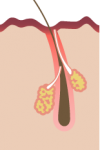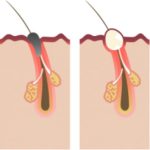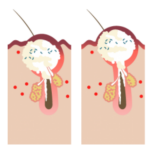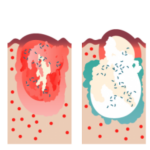Acne involves the oil (or sebaceous) glands in the skin.

1. These glands secrete an oil called sebum that naturally moisturizes the top layer of the skin. The highest concentrations of oil glands are found in the skin on the face, neck, chest, shoulders and back – areas where acne appears.
2. Acne usually begins at the start of puberty when hormone levels, particularly testosterone which is present in both males and females, surge. These hormones cause many changes within our bodies. One of these is to disrupt the skin’s normal processes. Dead skin cells in the pores are not shed as quickly as usual, stick together and pile up on the surface.

3. Oil glands within the skin, stimulated by hormones, enlarge and become overactive, pumping out excess oil. This oily substance combines with dead skin cells to clog skin pores. The earliest stages of acne appear – blackheads, clogged but open pores and whiteheads, plugged, closed pores.

4. Bacteria naturally present in the skin, P. acnes, thrive in these blocked, oily skin pores. The plugged pores may expand and break, and the bacteria may then add to the inflammatory reaction seen as redness and swelling. When inflammation happens below the surface of the skin, papules – many, small red bumps with or without pus inside appear. When inflammation happens above the skin, pustules (known as pimples), pus-filled spots can be seen. Pus is a yellowy-white fluid made of dead white blood cells released by the immune system, and cell debris.

5. Some people develop deep acne nodules and cysts. As pressure builds, the walls of skin pores burst and leak bacteria and fluid into the surrounding skin creating larger, deeper lesions called acne nodules.
6. The immune system creates fluid sacs around these areas to contain the damage. These boil-like lesions are cysts. Acne cysts and nodules are often painful. Since these are large and lodged deep, there is considerable injury to the skin. After healing, there can be scarring.
Test your acne knowledge. You may be surprised at some of the answers…